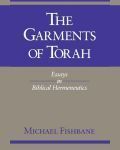Photo by Jr Korpa on Unsplash

Akenson, Donald Harman. Surpassing Wonder: The Invention of the Bible and the Talmuds (University of Chicago Press, 2001).
Elegant and inventive, Surpassing Wonder uncovers how the ancient Hebrew scriptures, the Christian New Testament, and the Talmuds of the Rabbis are related and how, collectively, they make up the core of Western consciousness. Donald Harman Akenson provides an incisive critique of how religious scholars have distorted the holy books and argues that it was actually the inventor of the Hebrew scriptures who shaped our concept of narrative history—thereby founding Western culture.

Alter, Robert and Frank Kermode, eds. A Literary Guide to the Bible (Belknap Press of Harvard University Press, 1990).
Particularly recommended is the essay by Gerard L. Bruns, “Midrash and Allegory: The Beginnings of Scriptural Interpretation.”
Rediscover the incomparable literary richness and strength of the Bible. An International team of renowned scholars offers and book-by-book guide through the Old Testaments as well as general essays on the Bible as a whole, providing an enticing reintroduction to a work that has shaped our language and thought for thousands of years.

Armstrong, Karen. The Bible: A Biography (Grove Press, reprint edition, 2008).
As the single work at the heart of Christianity, the world’s largest organized religion, the Bible is the spiritual guide for one out of every three people in the world. It is also the world’s most widely distributed book and its best-selling, with an estimated six billion copies sold in the last two hundred years. But the Bible is a complex work with a complicated and obscure history. Its contents have changed over the centuries, it has been transformed by translation and, through interpretation, has developed manifold meanings to various religions, denominations, and sects.
In this seminal account, acclaimed historian Karen Armstrong discusses the conception, gestation, life, and afterlife of history’s most powerful book. Armstrong analyzes the social and political situation in which oral history turned into written scripture, how this all-pervasive scripture was collected into one work, and how it became accepted as Christianity’s sacred text, and how its interpretation changed over time. Armstrong’s history of the Bible is a brilliant, captivating book, crucial in an age of declining faith and rising fundamentalism.

Cragg, Kenneth. The Event of the Qur’an (Oneworld, 1994).
Renowned author Kenneth Cragg examines the questions What happens in the Qur'an? in this uniquely comprehensive, scholarly, and historical study.

Cragg, Kenneth. The Garments of Torah: Essays in Biblical Hermeneutics (Indiana University Press, 1992).
In this almost painfully beautiful book... Fishbane... explores the question of the kind of canon, privileged status, or Logos, the Torah actually has for the post-modern Western Jew.
~Theology Today
A book well worth reading.
~ The Jerusalem Post
This wonderful volume documents the intellectual and spiritual odyssey of one of North America’s foremost Jewish biblical scholars.
~ Shofar

Gatje, Helmut. The Qur’an and Its Exegesis (Oneworld; 2nd edition, 1996).
This classic text brings together a unique collection of commentaries, translated from the original Arabic, on some of the key passages of the Qur'an.

Holcomb, Justin S., ed. Christian Theologies of Scripture: A Comparative Introduction (New York University Press; 2006).
All religious traditions that ground themselves in texts must grapple with certain questions concerning the texts' authority. Yet there has been much debate within Christianity concerning the nature of scripture and how it should be understood—a debate that has gone on for centuries.
Christian Theologies of Scripture traces what the theological giants have said about scripture from the early days of Christianity until today. It incorporates diverse discussions about the nature of scripture, its authority, and its interpretation, providing a guide to the variety of views about the Bible throughout the Christian tradition.
Preeminent scholars including Michael S. Horton, Graham Ward, and Pamela Bright offer chapters on major figures in the pre-modern, reformation, and early modern eras, from Origen and Aquinas to Luther and Calvin to Barth and Balthasar. They illuminate each thinker's understanding of the Christian scriptures and their views on interpreting the Bible. The book also includes overview chapters to orient readers to the key questions regarding scripture in each era, as well as chapters on scripture and feminism, scripture in the African American Christian tradition, and scripture and postmodernism.

Kraemer, David. The Mind of the Talmud: An Intellectual History of the Bavli (Oxford University Press, USA, 1990).
This critical study traces the development of the literary forms and conventions of the Babylonian Talmud, or Bavli, analyzing those forms as expressions of emergent rabbinic ideology. The Bavli, which evolved between the third and sixth centuries in Sasanian Iran (Babylonia), is the most comprehensive of all documents produced by rabbinic Jews in late antiquity. It became the authoritative legal source for medieval Judaism, and for some its opinions remain definitive today. Kraemer here examines the characteristic preference for argumentation and process over settled conclusions of the Bavli. By tracing the evolution of the argumentational style, he describes the distinct eras in the development of rabbinic Judaism in Babylonia. He then analyzes the meaning of the disputational form and concludes that the talmudic form implies the inaccessibility of perfect truth and that on account of this opinion, the pursuit of truth, in the characteristic talmudic concern for rabbinic process, becomes the ultimate act of rabbinic piety.

Schneidewind, William M. How the Bible Became a Book (Cambridge University Press, 2005).
How the Bible Became a Book combines recent archaeological discoveries in the Middle East with insights culled from the history of writing to address how the Bible was written and evolved into sacred Scripture. Written for general readers as well as scholars, the book provides rich insight into how these texts came to possess the authority of Scripture and explores why Ancient Israel, an oral culture, began to write literature. It describes an emerging literate society in ancient Israel that challenges the assertion that literacy first arose in Greece during the fifth century BCE.

Sells, Michael, Introduction and translation. Approaching the Qur’an: The Early Revelations (White Cloud Press, 2007).
A superb introduction to the Qur’an, it shows how the poetry works and comes with a CD of Qur’an recitations.
Approaching the Qur’án is a major event in religious publishing. Professor Michael Sells has captured the complexity, power, and poetry of the early suras of the Qur’án, the sacred scripture of Islam. In this second edition, Sells introduces important new translations of suras and a new preface that addresses the ongoing controversy over teaching about Islam and the Qur’an in American universities. Approaching the Qur’án presents brilliant translations of the short, hymnic suras associated with the first revelations to the Prophet Muhammad. Most of these early revelations appear at the end of text and are commonly reached only by the most resolute reader of existing English translations. These suras contain some of the most powerful, prophetic and revelatory passages in religious history. They offer the vision of a meaningful and just life that anchors the religion of one-fifth of the world’s inhabitants. Approaching the Qur'án is enriched by inclusion of free downloadable audio recordings of Quranic reciters, allowing readers an opportunity to hear the Qur'án in its original form. The book includes Sells’ Introduction to the Qur’án, commentaries of the suras, a glossary of technical terms, and chapters discussing the sound nature and gender aspects of the Arabic text.

Smalley, Beryl. The Study of the Bible in the Middle Ages (University of Notre Dame Press; 1st edition, 1989).
The Bible is the most widely read book in the world. From the transcription of the Old Testament to Greek, to the collection of the Gospels, the Bible has always been in a state of literary and scholarly transition. In her classic work, The Study of the Bible in the Middle Ages, Beryl Smalley describes the changes in the organization, technique, and purpose of Bible studies in northwestern Europe from the Carolingian renaissance to about 1300. This was the period when the emergence of Aristotelian thought inspired medieval scholars to take a fresh look at the Scriptures. The large number of medieval commentaries on the Bible confirms that they did so and that they expressed their reactions in writing.
Medieval historians and students of literature will find special value in this book: they will learn, in systematic fashion, what earlier scholars have accomplished in the field of exegesis; and they will be enabled to employ the history of biblical interpretation recounted here as a mirror for the social and cultural upheavals that were taking place simultaneously.

Smith, Wilfred Cantwell. What is Scripture? A Comparative Approach (Augsburg Books, 2000).
"Scripture" is no longer an absolute. In the last two centuries, as Westerners have become more keenly conscious of the historical character of their own biblical documents, they have also realized the normative function of scripture in other traditions. W.C. Smith's vastly erudite work asks how it is that certain texts have so seeped into human life - in a rich, complex and powerful way - as to be deemed sacred. Examining the history and use of scripture in the world's major religious traditions, he shows how and why scripture continues to carry momentous and at times appalling power in human affairs. That dynamic instability, that irrepressible process, and that stubborn pluralism are not simply modern embarrassments to believers. Rather, for Smith, they provide the essential clues to what "scripture" is. Smith first illustrates, by a fascinating look at the Song of Songs, how texts have both come into and passed out of their status as "scripture." He shows how one text has been differently deemed in Judaism and Christianity and strikingly variously interpreted in different settings and epochs. In ensuing chapters that explore the Jewish, Islamic, Hindu, Buddhist, and other instances, Smith lays bare the diverse strands of a complex historical process of scripture and its modern newly self-conscious phase. In the end, Smith's creative proposal is valuable not only for showing what it means to hold a text as sacred, or to treasure another's scripture, but also for the light it sheds in a troubled culture on what it means to be human.

